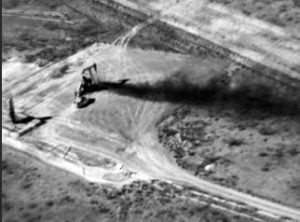In wake of Supreme Court ruling, we must go full steam ahead to reduce methane pollution
 The U.S. Supreme Court’s recent climate change ruling has unfortunately restricted the tools available to EPA in its effort to address climate pollution from power plants. However, it’s also important to recognize that the ruling in no way changed EPA’s longstanding authority and duty to address climate pollution under the Clean Air Act to address climate pollution itself — including from new cars and freight trucks, industrial sources, new and existing power plants, and oil and gas development. And with respect to oil and gas pollution, this decision in no way impedes the agency’s ongoing and important efforts to reduce oil and gas methane pollution.
The U.S. Supreme Court’s recent climate change ruling has unfortunately restricted the tools available to EPA in its effort to address climate pollution from power plants. However, it’s also important to recognize that the ruling in no way changed EPA’s longstanding authority and duty to address climate pollution under the Clean Air Act to address climate pollution itself — including from new cars and freight trucks, industrial sources, new and existing power plants, and oil and gas development. And with respect to oil and gas pollution, this decision in no way impedes the agency’s ongoing and important efforts to reduce oil and gas methane pollution.
It remains critical that the EPA exercise its clear authority and obligation to move forward with protective climate standards, including its proposed rules to curb methane pollution from the oil and gas sector, which emits roughly 16 million tons of methane annually. Globally, methane from human sources is responsible for over a quarter of the warming we are experiencing today.
EPA’s authority to tackle methane pollution was reaffirmed by bipartisan majorities in Congress just last year, and the agency has commonsense, cost-effective tools at hand to address the health harms posed by oil and gas methane pollution, which in the U.S. alone has the near-term climate impact every year of 294 million passenger vehicles.
In wake of Supreme Court ruling, we must go full steam ahead to reduce methane pollution Share on XCommonsense and cost-effective solutions
Actions to curb oil and gas methane emissions are among the fastest, most cost-effective ways to address pollution that threatens the health of 9 million Americans living within a half mile of an active oil or gas site.
Because methane is the main component of natural gas, a saleable energy resource, operators are able to eliminate many emissions at little to no net cost, and often turn a profit from implementing solutions.
According to the IEA, nearly half of emissions could be addressed at no net cost. In addition, analysis by Rystad Energy found that solutions for operators to end the practice of routine flaring — a significant source of methane pollution — are widely available and overwhelmingly cost-effective.
Many companies, ranging from global supermajors to independent operators, have voiced support for methane standards and are already implementing these solutions. Recent research also underscores the dramatic growth in the U.S. methane mitigation industry, which has over 1,000 employee locations across the country making solutions to find and fix emissions accessible to operators.
Furthermore, leading energy producing states like Colorado and New Mexico are demonstrating how practical and cost-effective methane safeguards are, with both states having enacted robust rules that address emissions from smaller wells with leak-prone equipment and end the practice of routine flaring.
Upcoming EPA standards for the oil and gas sector, which build on similar rules enacted by EPA in 2016, should leverage these widely-used and cost-effective solutions.
Clear authority and obligation for EPA to address climate pollution, including action on methane
Under the Clean Air Act, EPA has clear, longstanding authority, and responsibility, to set standards to address climate and other harmful pollution, including from the oil and gas sector. In fact, EPA first recognized the harmful impacts from the oil and gas sector in 1979 and issued its first standards addressing the sector’s emissions in 1985.
Methane is a powerful greenhouse gas and the oil and gas sector is its largest industrial source in the U.S. Recognizing this, EPA issued methane standards for new oil and gas sources in 2016.
Following this long history of standards reducing pollution from these sources, EPA’s obligation to address methane pollution from oil and gas was reaffirmed by bipartisan majorities in Congress just last year with a Congressional Review Act resolution restoring direct methane regulation under section 111 of the Clean Air Act.
In an amicus brief in the Supreme Court’s climate case, members of Congress explained that the CRA resolution underscores “EPA’s statutory obligation to regulate existing oil and gas sources under Section 111(d).”
Supreme Court ruling does not change path forward for EPA action on oil & gas methane
This climate change case does not affect EPA’s ability and obligation to swiftly address climate pollution, and methane pollution from the oil and gas industry is no exception. Indeed, the majority opinion recognizes EPA authority to address climate pollution under section 111 and explained that the agency must regulate existing sources once it set standards for new facilities.
While the opinion does constrict EPA’s ability to use some of the most cost-effective tools available to address climate pollution from existing power plants — even as it reaffirmed EPA’s authority and responsibility to limit that pollution — and concerningly give prominence to the newly invented and ambiguous “major questions doctrine,” the issues in the case that the court found problematic aren’t relevant to the EPA’s proposed oil and gas methane rules.
Indeed, the technology-based and source-focused pollution safeguards EPA has proposed for the oil and gas sector are the very types of standards the Court recognized as squarely within EPA’s longstanding authority under the Clean Air Act. EPA must move forward and swiftly address climate pollution and must finalize methane protections across the oil and gas sector to protect public health and welfare.










